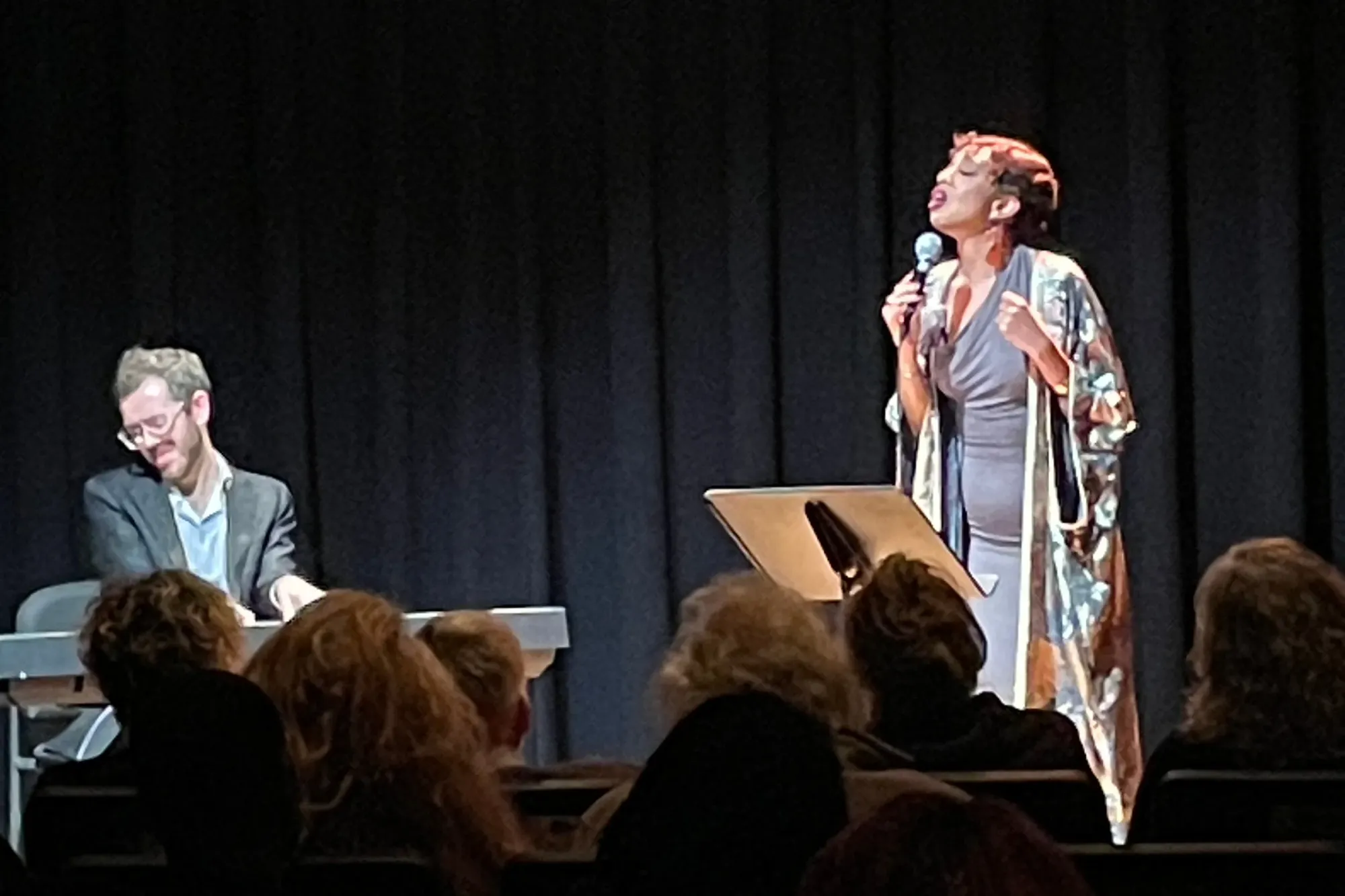Tahira Clayton
Woody Guthrie Center
Tulsa
Dec. 9, 2023
What do Woody Guthrie and Billie Holiday have in common? A recent concert teased out some answers to that question, anchored in the Woody Guthrie Center’s Billie Holiday at Sugar Hill exhibit, which runs through Jan. 14. The exhibit features stunningly intimate photos of Lady Day in 1957 (two years before her death) by Jerry Dantzic, highlighting the inimitable jazz star’s humor and joy.
Holiday wasn’t just a tragic, tortured artist, as current-day jazz singer Tahira Clayton solidified for about 60 of us (a full house) during her show at the WGC’s theater last weekend. Clayton, an accomplished vocalist, lyricist, and activist in her own right, alongside Addison Frei on keys, took us on a “journey with Billie,” celebrating Holiday’s legacy and delighting in some of her most popular and powerful tunes. They opened with the playful “After You’ve Gone,” a song recorded in 1927 by Bessie Smith, the “Empress of the Blues” who helped to pave the way for Holiday and a long line of visionary Black women in music.
Early in the set, Clayton — with rose-red lips, pixie-cut hair in perfect finger waves, bold red earrings — recalled an initial fear of getting close to Holiday’s music. As a kid, she’d sensed her small body couldn’t contain all the feeling Lady Day’s voice carried (think of the deep yet delicate vocals in “I’ll Be Seeing You,” for instance). What she found later, though, was that in live recordings, Holiday sang even her saddest songs with a hint of irony: I’ve been there. Done that. Made it through. Good morning, heartache, sit down.
Clayton spoke warmly, candidly, between songs, calling us friends. The WGC’s black-box theater lends itself to this sort of intimacy, isolating and emphasizing the sound and light that emanate from the small stage. She said if we were to take one thing from her set that night, she hoped it’d be that Holiday was a powerful force for civil rights at the time. She was one of the first Black vocalists to headline an all-white group (the Artie Shaw Orchestra, 1938), and she tirelessly fought to perform the songs she found important.
Holiday got her start singing popular songs, many of which Clayton and Frei brought to life for us: “They Can’t Take That Away From Me,” “St. Louis Blues,” “Body and Soul.” But her indelible impact is arguably found most strongly in one single song — “Strange Fruit” — that tested audiences and put the feds on her back, resulting in a years-long campaign to get her to stop. Holiday was a bold, powerful Black artist who was shaking things up — and it was no secret that she was addicted to heroin. We can’t ignore the darker parts of her story, like the Federal Bureau of Narcotics’ crusade, which involved planting drugs on the star and sentencing her to a year in prison, then revoking her cabaret card, which meant she couldn’t get into the clubs to play — and make money.
But she kept fighting. She kept singing “Strange Fruit,” one of the most potent, heart-wrenching, gutting songs of all time. A protest song that faces the brutal reality of the lynchings of Black Americans. We got to hear the song that night. I’ve never heard an audience so silent, so reverent. Clayton captured the thing in Holiday’s voice, and she captured us. And then came the onset of sniffles throughout the crowd.
Just: Damn.
Clayton finished her set with “God Bless the Child,” urging us to ask about the meaning of the song after the show. And that’s what I love about this venue. Whether it’s an exhibit like Dantzic’s or a thematically linked performance, you’re right there with the visionaries, always reminded that artists are often at the forefront of social causes, constantly making real-world impacts in their own ways. If you don’t think Woody Guthrie and Billie Holiday are cut from the same cloth, think again.
Next at the Woody Guthrie Center: Real Talk: Strange Fruit: The Art and Activism of Billie Holiday, Dec. 16.






